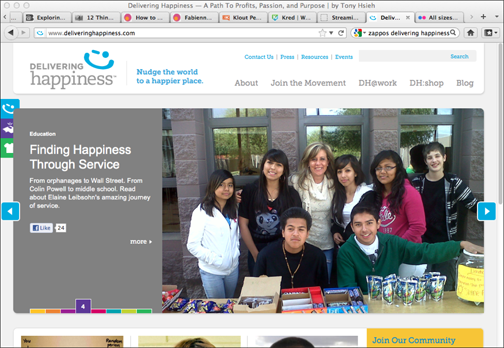Empowering Your Social Media Team and Employees
The most vibrant and healthy social media teams feel empowered to do random acts of kindness for your customers. Savvy companies like Zappos (see the sidebar, “Delivering happiness,” nearby) empower their social media team members.
There are many documented stories of people who received flowers or a card during a major life event from a well-run social media team. (Zappos is famous for doing this.)
When you give your team members more control over how they can develop relationships with customers, you’ll have happier employees, and most likely happier customers. Give them a variety of tools they can use at their own discretion simply to brighten up somebody’s day. They can use these to spread goodwill to customers however it pleases them. Ideas include
![]() Free product samples
Free product samples
![]() Discounts
Discounts
![]() Advance notification of special events
Advance notification of special events
![]() A budget of $100 a month for discretionary spending on clients
A budget of $100 a month for discretionary spending on clients
![]() Beautiful stationery and postage, in case your team member feels moved to write something to brighten a particular client’s day
Beautiful stationery and postage, in case your team member feels moved to write something to brighten a particular client’s day
Oh! One more thing: Zappos calls its concept “delivering happiness.” I agree.
Creating your own successful online community
Your online community should evolve naturally. It’s what happens when your organization’s voice resonates with your audiences. Still, to get things moving, try these tips:
![]() Ask if people need help (and then help them or direct them to great resources): For example, if you are a licensed tax preparer, you may ask people to fire away with their questions. Choose some that are more broadly applicable and answer them. Refer them to quality resources for more information, if necessary.
Ask if people need help (and then help them or direct them to great resources): For example, if you are a licensed tax preparer, you may ask people to fire away with their questions. Choose some that are more broadly applicable and answer them. Refer them to quality resources for more information, if necessary.
![]() Ask people to help you: Post a question or a problem and see what happens. You can even ask people in your online community to help you with product development. For example, if you sell fingerless gloves, you may ask your friends in your community whether they think matching scarves or hats that appear to have holes in them are an appealing idea.
Ask people to help you: Post a question or a problem and see what happens. You can even ask people in your online community to help you with product development. For example, if you sell fingerless gloves, you may ask your friends in your community whether they think matching scarves or hats that appear to have holes in them are an appealing idea.
Taking a stand for individual accounts
As you set up your social media teams (see Chapter 3 for the full deal), consider having your members use individualized accounts with their real names. They can still share personal information with those closest to them on social networks. There are definite benefits to keeping it personal, including the following:
![]() Personal accounts get treated better: Web anonymity makes cruelty easy online. The less anonymous you are, then, the less likely you’ll be treated on the web with cruelty. It’s harder to be mean to someone whose avatar is a photograph — that is, a real person’s face — than to someone with a depersonalized picture, like a logo. Most people respond more warmly to the profile of an authentic-looking person with a realistic profile.
Personal accounts get treated better: Web anonymity makes cruelty easy online. The less anonymous you are, then, the less likely you’ll be treated on the web with cruelty. It’s harder to be mean to someone whose avatar is a photograph — that is, a real person’s face — than to someone with a depersonalized picture, like a logo. Most people respond more warmly to the profile of an authentic-looking person with a realistic profile.
![]() A human face will emerge from behind your corporate mask: What better way to win friends and influence people than to humanize your brand?
A human face will emerge from behind your corporate mask: What better way to win friends and influence people than to humanize your brand?
![]() You can connect more easily: It’s human nature to want to connect with people rather than things. Even though Fortune 100 companies spend a lot of time and money trying to humanize their brands, the truth is most people will never feel as warm and fuzzy, or allow themselves to be vulnerable, or be as trusting with a faceless corporate entity as they will with a warm, authentic person.
You can connect more easily: It’s human nature to want to connect with people rather than things. Even though Fortune 100 companies spend a lot of time and money trying to humanize their brands, the truth is most people will never feel as warm and fuzzy, or allow themselves to be vulnerable, or be as trusting with a faceless corporate entity as they will with a warm, authentic person.
Earning trust
It’s kind of ironic, but simply telling someone to trust you automatically triggers suspicion. It doesn’t matter whether you’re speaking the truth or not. People want results, not empty promises.
Start building trust by promising small things, like helpful blog posts, and then delivering on those promises. Then surprise your audience by exceeding its expectations — give them bonus materials, such as white papers, how-to videos, or infographics. Or offer a free e-book or a discount on a hot product. You get the idea.
Always make sure you’re giving them something meaningful or useful, and with no strings attached. Try these ideas:
![]() Share informational giveaways that are genuinely important to your “tribe.”
Share informational giveaways that are genuinely important to your “tribe.”
![]() Explain why the issue you discuss in your informational giveaways is important.
Explain why the issue you discuss in your informational giveaways is important.
![]() Give some good foundational information for what to do about the issue you explore in your informational giveaway.
Give some good foundational information for what to do about the issue you explore in your informational giveaway.
People still need to come to you for how to apply these things, so you can earn their trust over time by answering their questions. Remember that you don’t have to “give away the farm” with every post or response; you just have to deliver value and maybe point people to a more comprehensive, paid solution that you offer.
Resolving issues patiently
Patience is most definitely a virtue, but it’s a lot easier to cultivate and maintain when you feel like you have some solid backup.
Having an internal FAQ on Google Docs or some other internal network keeps your social media team informed about every important development. When you keep it simple like this, you set your team up to succeed, even with the unhappiest customer.
Your people will be able to
![]() Respond quickly
Respond quickly
![]() Act decisively
Act decisively
![]() Think on their feet to brainstorm solutions that fit
Think on their feet to brainstorm solutions that fit
Demonstrating human vulnerability
Nobody knows it all, and if she says she does, I start running! It’s okay to admit that you need to think something through when you’re a business owner, or to draw a blank when being asked an important question. People respect you when you
![]() Level with them
Level with them
![]() Promise to get back with them
Promise to get back with them
![]() Deliver on that promise within a reasonable time frame
Deliver on that promise within a reasonable time frame
Winning passionate fans
One of the biggest differences between new media and old days is how people expect to communicate with companies. Once upon a time, it was okay to make people wait in line, face a receptionist, or write a letter that never gets answered. Fortunately for consumers, those days are gone.
It only follows that communicating with people via social media should feel as much like a warm, face-to-face encounter as possible. When you give people a cheerful, real person to talk to about their problems, somebody who knows what they’re talking about and gets happy at the thought of helping people, you win passionate fans who will defend you and share their great stories about you with their friends.



